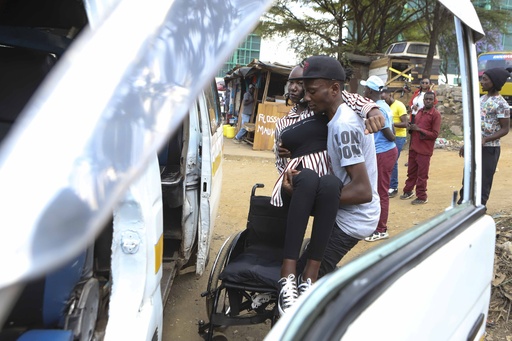
NAIROBI, Kenya — At the age of 13, Caroline Mwikali lost the ability to walk due to an illness, leading her to discover the challenges of mobility in Kenya’s bustling capital, Nairobi. Now employed at a car financing firm, Mwikali expresses her frustration with the public transport system, which fails to cater to individuals who rely on wheelchairs.
The most common transportation modes in Nairobi include motorbikes and minivans, neither of which provides ramps or designated spaces for wheelchairs. Passengers in need of assistance often have to be lifted from their wheelchairs onto regular seats, leaving their mobility aids stored away with luggage. Mwikali shared her experience: “Typically, staff at the bus terminals would have to physically lift you out of your wheelchair to help you get on the bus. This situation is not only uncomfortable but also draws unwanted attention,” she stated.
In Kenya, approximately 900,000 people, representing 2.2% of the population, live with disabilities, with mobility impairments affecting 42% of them. Recognizing the need for better transportation options, entrepreneur Daniel Gatura established Ace Mobility in 2021. His company modifies vehicles to include ramps and swivel seats, making travel more accessible for people with disabilities and others requiring assistance.
Gatura’s inspiration for creating Ace Mobility stems from personal experience. “My father incurred a spinal cord injury in an accident when he was just five. I witnessed firsthand the struggles he faced, including losing his job because he couldn’t find suitable transportation,” he shared.
Passengers can easily book rides via the Ace Mobility app, and drivers are trained to serve as caregivers, ensuring respectful and proper support is given to passengers with disabilities. Gatura remarked that the service has already garnered 5,000 users. “We aim to change perceptions regarding disability and mobility issues. Having a disability does not define one’s ability to contribute economically to society,” he stated.
However, while Ace Mobility offers a valuable service, it is priced higher than regular public transport, costing about $1 per kilometer. For comparison, that amount could fund a 40-kilometer ride on standard transport. Despite the higher cost, Gatura emphasized the benefit of direct-to-home service. Mwikali, who has utilized Ace Mobility for four months after being referred by a friend, commented, “I find the fares reasonable given the convenience. I can travel without needing to leave my chair, preserving my dignity in the process.”
Conversely, some individuals like Cindy Cherotich have difficulty accessing this service. Using crutches, Cherotich faces challenges when trying to board minibuses. “At the bus station, sometimes the public vehicles refuse to let me on. If they see my crutch, and someone without one, they will prioritize them,” she explained.
Lucy Nkatha, a disability advocate and coordinator at the Kiengu Women Challenged to Challenge Group, an NGO, admitted she was unaware of Ace Mobility and emphasized the need for better marketing for such companies. “It’s important that these services are made more affordable,” she added.
Sandra Nyawira, who advises on disability inclusion at United Disabled Persons of Kenya, pointed out that Kenya does have policies to support individuals with disabilities, yet these often go unimplemented. She stressed the need for more political commitment to make a real difference. “Having policies in place is one thing, but executing them is entirely another,” Nyawira remarked.
